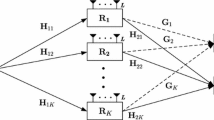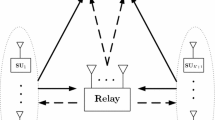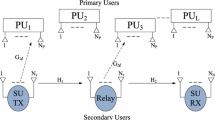Abstract
We study the optimal precoder design for a MIMO cognitive two-way relay system with underlay spectrum sharing. The system consists of two secondary users (SUs) and one relay station (RS). We jointly optimize the precoders for SUs and RS with perfect and imperfect channel state information (CSI) between SUs/RS and the primary user, where our design approach is based on the alternate optimization method. For the perfect CSI case, we derive the optimal structure of the RS precoding matrix, which generalizes the result for single-antenna SUs and helps to reduce the search complexity. We develop gradient projection (GP) algorithm to calculate the optimal RS precoder numerically. When the RS precoder is given, we propose a fast algorithm based on generalized water-filling theorem to compute the optimal SU precoders. For the imperfect CSI case, we derive equivalent conditions for the interference power constraints and convert the robust SU precoder optimization into the form of semi-definite programming. As for the robust RS precoder optimization, we relax the interference power constraint related with the RS precoder to be convex and then the GP algorithm can be applied. Finally, simulation results demonstrate the effectiveness of the proposed schemes.







Similar content being viewed by others
References
Haykin, S. (2005). Cognitive radio: Brain-empowered wireless communications. IEEE Journal on Selected Areas in Communications, 23(2), 201–220.
Zhao, Q., & Sadler, B. M. (2007). A survey of dynamic spectrum access. IEEE Signal Processing Magazine, 24(3), 79–89.
Ghasemi, A., & Sousa, E. S. (2007). Fundamental limits of spectrum-sharing in fading environments. IEEE Transactions on Wireless Communications, 6(2), 649–658.
Luo, L., Zhang, P., Zhang, G., & Qin, J. (2011). Outage performance for cognitive relay networks with underlay spectrum sharing. IEEE Communications Letters, 15(7), 710–712.
da Costa, D. B., Aïssa, S., & Cavalcante, C. C. (2012). Performance analysis of partial relay selection in cooperative spectrum Sharing systems. Wireless Personal Communications, 64(1), 79–92.
Ho-Van, K. (2012). Exact outage probability of underlay cognitive cooperative networks over rayleigh fading channels. Wireless Personal Communications. doi:10.1007/s11277-012-0742-z.
Li, L., Zhao, X., Xu, H., et al. (2011). Simplified relay selection and power allocation in cooperative cognitive radio systems. IEEE Transactions on Wireless Communications, 10(1), 33–36.
Zarifi, K., Affes, S., Ghrayeb, A. (2011). Joint source power control and relay beamforming in amplify-and-forward cognitive networks with multiple source-destination pairs. In Proceedings of IEEE ICC (pp. 1–6). Kyoto: Japan.
Duong, T. Q., Bao, V. N. Q., & Zepernick, H.-J. (2011). Exact outage probability of cognitive AF relaying with underlay spectrum sharing. Electronic Letters, 47(17), 1001–1002.
Zhang, R., & Liang, Y. C. (2008). Exploiting multi-antennas for opportunistic spectrum sharing in cognitive radio networks. IEEE Journal of Selected Topics in Signal Processing, 2(1), 88–102.
Jitvanichphaibool, K., Liang, Y.C., Zhang, R. (2009). Beamforming and power control for multi-antenna cognitive two-way relaying. In Proceedings of IEEE WCNC (pp. 1–6). Budapest: Hungary.
Fang, Z., Hua, Y., Koshy, J.C. (2006). Joint source and relay optimization for a non-regenerative MIMO relay. In Proceedings of IEEE workshop on sensor array multichannel signal processing. Waltham, MA, England.
Mo, R., & Chew, Y. (2009). Precoder design for non-regenerative MIMO relay systems. IEEE Transactions on Wireless Communications, 8(10), 5041–5049.
Yu, Y., & Hua, Y. (2010). Power allocation for a MIMO relay system with multiple-antenna users. IEEE Transactions on Signal Processing, 58(5), 2823–2835.
Zhang, L., Liang, Y. C., Xin, Y., & Poor, H. V. (2009). Robust cognitive beamforming with partial channel state information. IEEE Transactions on Wireless Communications, 8(8), 4143–4153.
Zheng, G., Wong, K. K., & Ottersten, B. (2009). Robust cognitive beamforming with bounded channel uncertainties. IEEE Transactions on Signal Processing, 57(12), 4871–4881.
Bengtsson, M., & Ottersten, B. (2001). Optimum and suboptimum transmit beamforming. In L. C. Godara (Ed.), Handbook of antennas in wireless communications. Boca Raton, FL: CRC.
Bertselas, D. P. (1999). Nonlinear programming (2nd ed.). Belmont, MA: Athena Scientific.
Boyd, S., & Vandenberghe, L. (2004). Convex optimization. Cambridge: Cambridge University Press.
Ben-Tal, A., & Nemirovski, A. (2001). Lectures on modern convex optimization: analysis, algorithms, and engineering applications. Philadelphia, PA: SIAM.
Grant, M., Boyd, S. CVX: Matlab Software for Disciplined Convex Programming [Online]. Available: http://cvxr.com/cvx.
Magnus, J., & Neudecker, H. (2007). Matrix differential calculus with applications in statistics and econometrics. New York: Wiley.
Beck, A., & Eldar, Y. (2006). Strong duality in nonconvex quadratic optimization with two quadratic constraints. SIAM Journal on Optimization, 17(3), 844–860.
Acknowledgments
This work was supported by the National Natural Science Foundation of China under Grand Nos. 61173148 and 61202498, the Industry-University-Research Project of Guangdong Province and the Ministry of Education under Grand No. 2011B090400581, the Scientific and Technological Project of Guangzhou City under Grands Nos. 12C42051578 and 11A11060133.
Author information
Authors and Affiliations
Corresponding author
Appendices
Appendix 1: Proof of the Convexity of the Constraint Set in (25)
Let \(\mathbf{Q}=\sum ^{2}_{i=1}\mathbf{H}_{i}\mathbf{Q}_{i}\mathbf{H}^{\dag }_{i}+\mathbf{I}\), then \(p_{R}=\text {Tr}(\mathbf{F}\mathbf{Q}\mathbf{F}^{\dag })\) and \(I_r=\text {Tr}(\mathbf{G}_{3}\mathbf{F}\mathbf{Q}\mathbf{F}^{\dag }\mathbf{G}_{3}^{\dag })\). We assume \(\mathbf{F}_{1}, \mathbf{F}_{2}\in \mathbb {C}^{M\times M}\) such that
Define \({\bar{\mathbf{F}}}=\beta _{1}\mathbf{F}_{1}+\beta _{2}\mathbf{F}_{2}\) where \(\beta _{1}, \beta _{2}\ge 0\) and \(\beta _{1}+ \beta _{2}=1\). Then
Let \(\mathbf{A}\triangleq \mathbf{G}_{3}\mathbf{F}_{1}\mathbf{Q}^\frac{1}{2}\) and \(\mathbf{B}\triangleq \mathbf{G}_{3}\mathbf{F}_{2}\mathbf{Q}^\frac{1}{2}\), using the fact that \(\text {Tr}(\mathbf{AB}^{\dag }+\mathbf{BA}^{\dag })\le \text {Tr}(\mathbf{AA}^{\dag }+\mathbf{BB}^{\dag })\), we obtain
Similarly, we have \(\text {Tr}({\bar{\mathbf{F}}}\mathbf{Q}{\bar{\mathbf{F}}}^{\dag })\le P_{R}\). Therefore the constraint set w.r.t. \(\mathbf{F}\) is convex and it is also convex w.r.t. \(\mathbf{P}\) since \(\mathbf{F}\) and \(\mathbf{P}\) is linear relation.
Appendix 2: Derivation of (26)
To derive the derivative w.r.t. \(\mathbf{P}\), we need the properties: \(\text {d}\ln \det (\mathbf{X})=\text {Tr}(\mathbf{X}^{-1}\text {d}\mathbf{X})\), \(\text {d}(\mathbf{X}\mathbf{Y})=\text {d}\mathbf{X}\mathbf{Y}+\mathbf{X}\text {d}\mathbf{Y}\) [22]. Then we have
Using the relations [22]: \(\text {d}f(\mathbf{X})=\text {Tr}(\mathbf{A}\text {d}\mathbf{X})\Leftrightarrow \frac{\partial f(\mathbf{X})}{\partial \mathbf{X}}=\mathbf{A}^{T}\) and \(\frac{\partial f(\mathbf{X})}{\partial \mathbf{X}^{\dag }}=\mathbf{0}\), we have
Appendix 3: S-Procedure for Complex Case [23]
Given Hermitian matrices \(\mathbf{A}_{i}\in \mathbb {C}^{n\times n}\), vectors \(\mathbf{b}_{i}\in \mathbb {C}^{n\times 1}\) and numbers \(c_{i}\in \mathbb {R}\) for \(i=0,1,2\). Define the functions \(f_{i}(\mathbf{x})=\mathbf{x}^{\dag }\mathbf{A}_{i}\mathbf{x}+ 2\text {Re}\{\mathbf{b}^{\dag }_{i}\mathbf{x}\}+c_{i}\). If there exists a vector \(\mathbf{x}\in \mathbb {C}^{n\times 1}\) such that \(f_{1}(\mathbf{x}), f_{2}(\mathbf{x})>0\), then the following two conditions are equivalent:
-
1)
\(f_{0}(\mathbf{x})>0\) for every \(\mathbf{x}\in \mathbb {C}^{n\times 1}\) such that \(f_{1}(\mathbf{x})\ge 0\) and \(f_{2}(\mathbf{x})\ge 0\);
-
2)
there exists \(\lambda _{1}, \lambda _{2}\ge 0\) such that
Rights and permissions
About this article
Cite this article
Li, Q., Luo, L., Zhang, G. et al. Optimal Precoder Design for Non-Regenerative MIMO Cognitive Two-Way Relay Systems with Underlay Spectrum Sharing. Wireless Pers Commun 75, 1373–1390 (2014). https://doi.org/10.1007/s11277-013-1429-9
Published:
Issue Date:
DOI: https://doi.org/10.1007/s11277-013-1429-9




